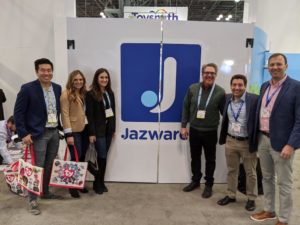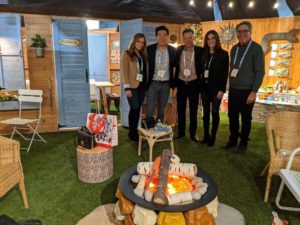By Kara Sherrer
 In February, three Owen MBA students and Dean Johnson were invited to attend the Toy Fair Association Conference in New York City. Held annually, the global conference is an opportunity for manufacturers to show off their latest toys and innovations to investors, media, and retailers. The students were asked to attend after creating a wide-ranging industry report that looked at current and future trends.
In February, three Owen MBA students and Dean Johnson were invited to attend the Toy Fair Association Conference in New York City. Held annually, the global conference is an opportunity for manufacturers to show off their latest toys and innovations to investors, media, and retailers. The students were asked to attend after creating a wide-ranging industry report that looked at current and future trends.
“Our students developed an insightful report that found its way into the boardrooms of many toy makers and the Toy Association itself,” said Dean M. Eric Johnson.
The report followed up on one published by Owen students five years ago, which looked at the state of the toy industry and made predictions for the future. Given how much the toy industry has changed within the past few years — especially in the wake of the Toys R’ Us shutdowns — Dean Johnson felt like it was time to produce an updated report. He extended the opportunity first to Dean’s Scholars and then opened it up to a select group of interested students.
Natasha Karimzadeh, Katie Smigelski, and Quinn Shue (all MBA’20) volunteered for the independent student project. They received course credit for their work, conducting an extensive set of interviews with top industry executives and industry analysts along with their own research during Mods I and II. For the interviews, Dean Johnson and the Toy Association introduced the team to industry experts, including many Owen alumni. Karimzadeh, who used to work at Mattel, also reconnected with her industry networks.
“All of us saw this as a kind of industry-broadening opportunity, especially for me and Katie — trying something new and researching a different topic than we’re used to,” Shue said.
Three main trends emerged from their research. First, they looked at retail consolidation in the wake of the Toys R’ Us closures. Big box stores and online retailers like Amazon, Target, and Walmart are capturing these extra toy sales, as are non-traditional retailers like Kohl’s and Best Buy. Second, they looked at changing behaviors: kids are playing differently. While the age range in which kids are playing with traditional toys has long been debated, 360-play patterns are creating new opportunities to combine toys and digital content. Finally, the team examined sustainability and related trends and how these are impacting the toy industry.
 “I’m really interested in focusing on the retail industry — actually, in my internship this past summer, we did a turnaround case for a retailer — and so I definitely saw some similarities in terms of trying to understand the consolidation in this industry versus others, and how you compete against Amazon as well as the online players as a brick and mortar,” Smigelski said of their findings.
“I’m really interested in focusing on the retail industry — actually, in my internship this past summer, we did a turnaround case for a retailer — and so I definitely saw some similarities in terms of trying to understand the consolidation in this industry versus others, and how you compete against Amazon as well as the online players as a brick and mortar,” Smigelski said of their findings.
The group submitted the final report around Thanksgiving and received such a positive response that the Toy Association distributed it to its nearly 1,000 member firms. Soon after, the team was invited to Toy Fair conference in NYC. Of course, the group said yes.
“Between ourselves and the Dean, we were able to set up appointments with a lot of alumni (at the conference), which was really great,” Karimzadeh said. “They were kind enough to take us through and show us some of their products and also kind to talk through some of the trends and macro trends we’re seeing in the industry, which really aligned to some of the key highlights of the report we wrote.”
While the report hasn’t been available that long, the team has gotten positive feedback so far and says that some toy manufacturers have already circulated their findings. “One thing that was pretty neat was getting executives to listen to what we’re writing,” Shue said. “Natasha mentioned that our toy paper was being cycled around at Mattel, which is in and of itself kind of scary, but also interesting that a lot of us got introduced to the toy industry just five months ago, and people are taking our thoughts and potentially putting them into action.”